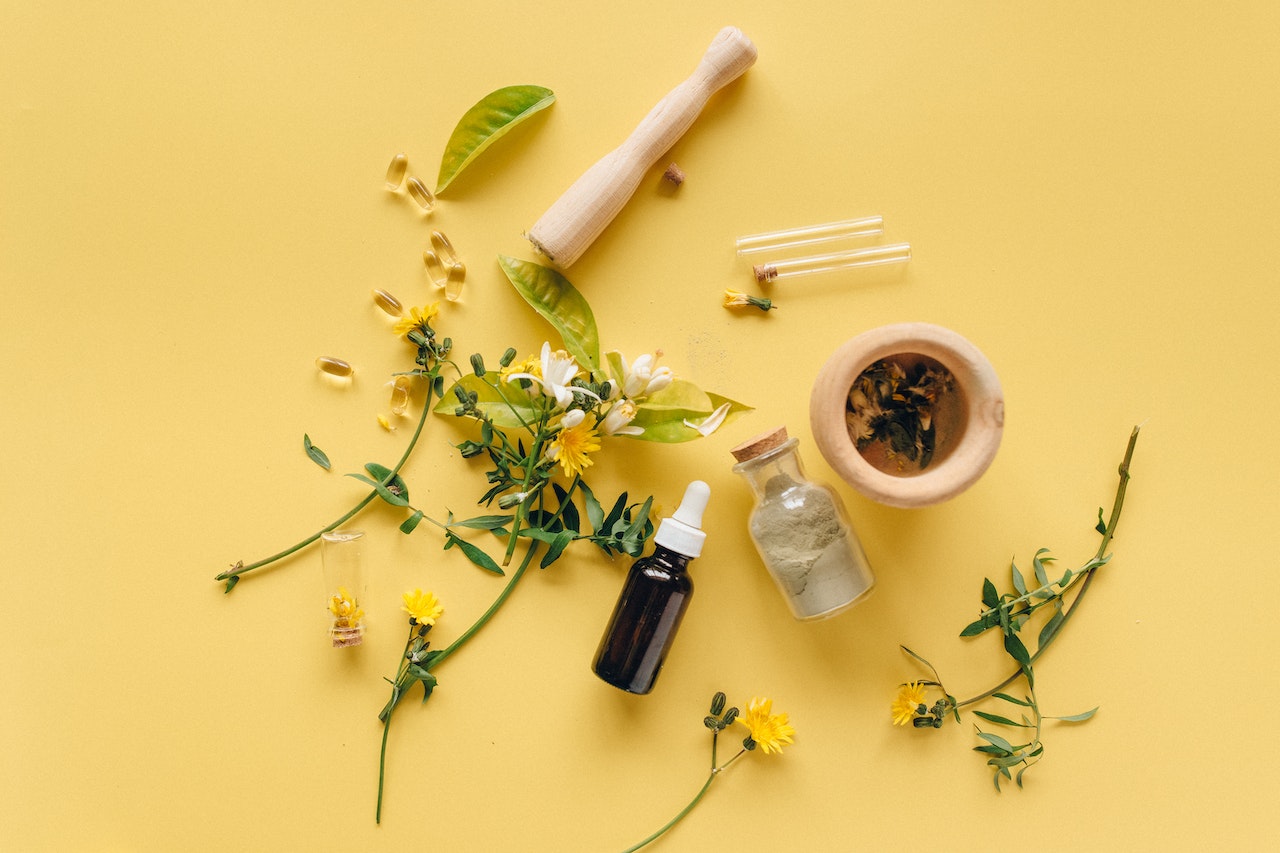Do you want to know what are the health benefits of healing herbs? Traditional medical procedures and herbal medicines have endured through the decades in the busy world of contemporary medicine, providing a wealth of health advantages. It has been known for thousands of years that certain societies have used medicinal plants to treat various health issues.
A healing herb, sometimes called a medicinal plant, is harvested from the wild or cultivated specifically for its therapeutic or curative properties. Herbal treatments can be made using a plant’s leaves, stems, bark, seeds, roots, and flowers. This article discusses the historical use of these medicinal herbs, the findings of the research, how to use them, and things to keep in mind.
Remember that while herbal treatments may be beneficial as adjunct therapies, they are not miracle cures. They can also have hazards and adverse effects; neither their safety nor efficacy are subject to Food and Drug Administration regulation. So let’s get started!
What is Herbal Medicine?
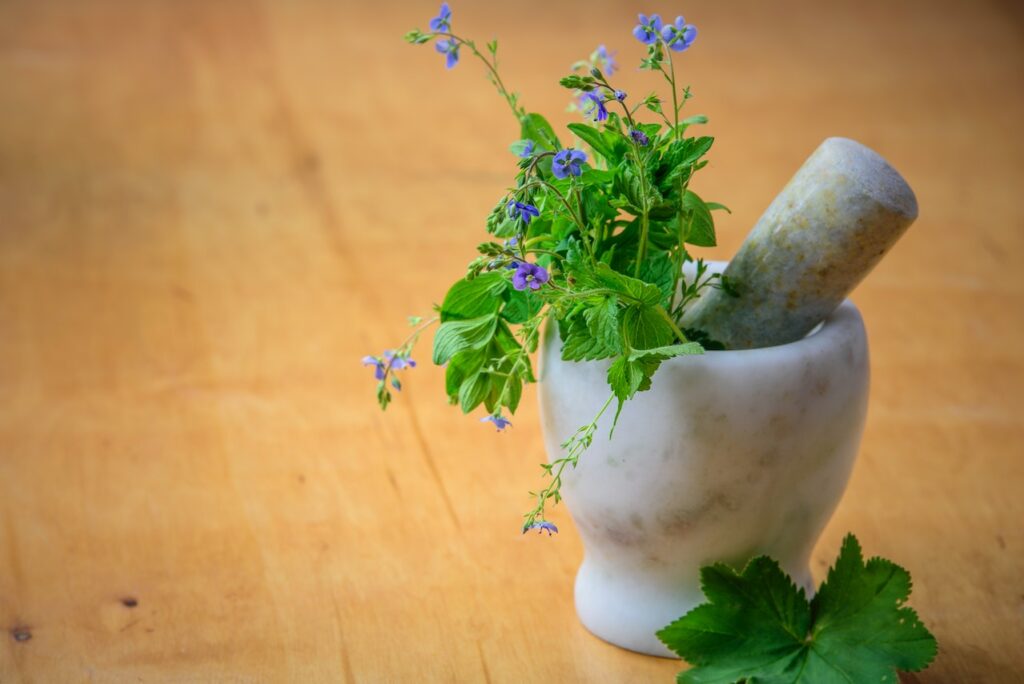
The use of herbal medicine dates back to early civilizations. It entails using plants as medicines to cure illness and improve people’s overall health and wellness. Some plants should be used with a similar level of caution as pharmaceutical drugs because they contain potent (strong) components. Many pharmaceutical drugs are artificial derivatives of naturally occurring plant components.
For instance, the foxglove plant was the source of the cardiac medication Digitalis. An herb is any plant used for smell, flavor, or medical purposes, including its seeds, flowers, and leaves. Herbs with medicinal properties can be added to your medical cabinet and favorite dishes. There are hundreds of medicinal plants, many of which individuals take routinely without realizing the advantages to their health.
The Health Benefits of Healing Herbs
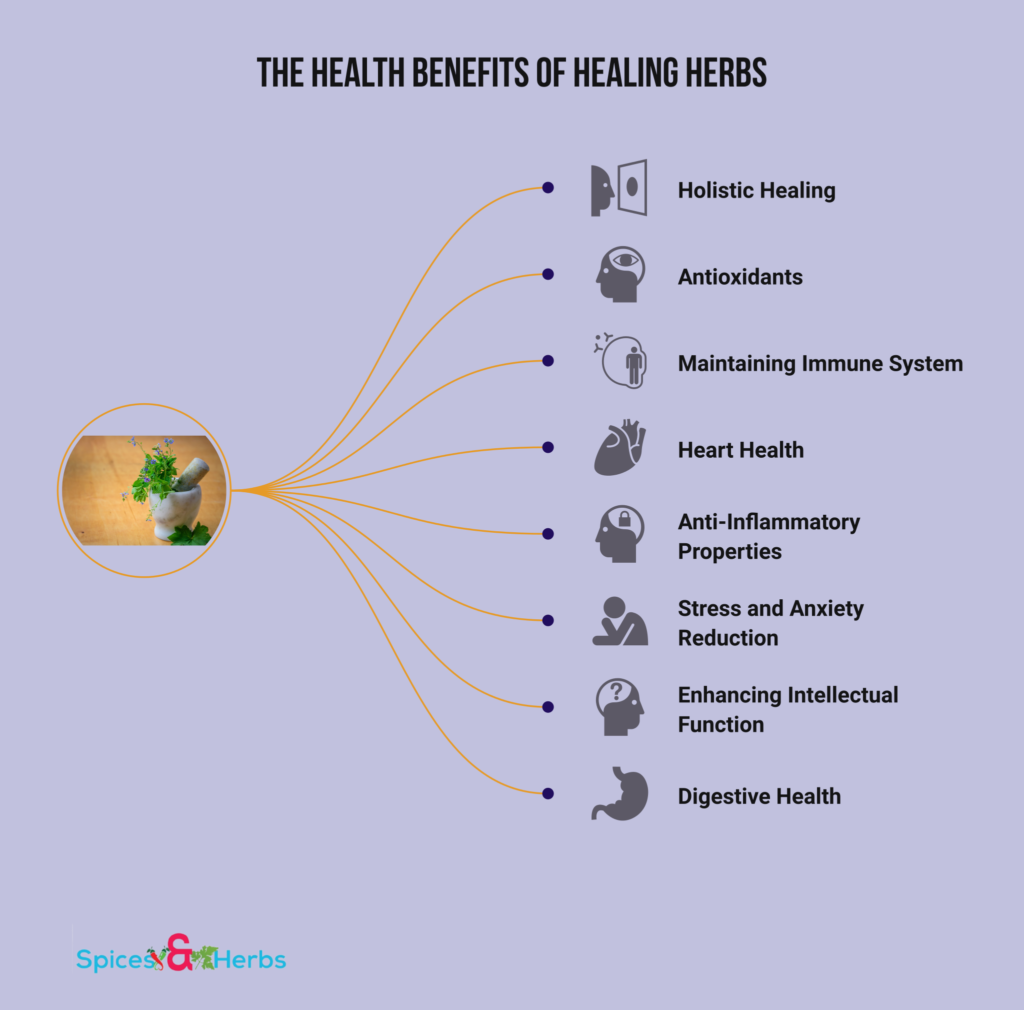
Herbs that enhance health and well-being have been utilized for ages by people from many different cultures. Many of these plants include substances that have been found to have potential health advantages. However, their efficacy may differ from person to person. Here are some popular medicinal plants along with the health advantages they bring.
Holistic Healing
Unlike many traditional medications, healing herbs address health holistically. They frequently attempt to reestablish harmony and balance within the mind, body, and spirit rather than concentrating only on curing certain symptoms. The interdependence of many physiological systems is acknowledged by this holistic approach, which promotes total well-being rather than only treating specific problems.
Antioxidants
Numerous medicinal plants contain significant amounts of antioxidants essential for scavenging the body’s dangerous free radicals. Free radicals are unstable chemicals that can harm cells, speed up aging, and develop chronic illnesses. People can strengthen their body’s defense against inflammation and oxidative stress by ingesting antioxidant-rich plants like ginger, turmeric, & green tea.
Maintaining Immune System
The body’s initial line of defense against illnesses and infections is a robust immune system. Echinacea, astragalus, & elderberry are a few herbs that have been demonstrated to boost immune function, enabling the body to fight off infections more successfully.
Heart Health
Many plants have been investigated for their conceivable cardiovascular advantages. By enhancing blood flow, lowering blood pressure, and bolstering the heart muscle, hawthorn has long been utilized to enhance heart health. Another benefit of garlic is that it lowers cholesterol and improves blood circulation.
Anti-Inflammatory Properties
Numerous health problems, such as heart disease, arthritis, and several malignancies, are associated with chronic inflammation. Numerous medicinal plants, like turmeric (which contains the active ingredient curcumin), boswellia, and ginger, have strong anti-inflammatory characteristics that can help reduce inflammation and the dangers that go along with it.
Stress and Anxiety Reduction
In the fast-paced world of today, worry and anxiety are common worries. People have used herbal treatments like lavender, chamomile, and passionflower for generations to relax and quiet their nervous systems. These herbs can reduce stress and improve sleep, enhancing mental health.
Enhancing Intellectual Function
Some medicinal plants, like ginkgo biloba & gotu kola, improve memory and cognitive function. In traditional medicine, these herbs have been used to enhance brain health and may help prevent age-related cognitive decline.
Digestive Health
Digestive health can also benefit from healing herbs. The well-known remedies for bloating, indigestion, and irritable bowel syndrome (IBS) are peppermint, ginger, and fennel. They can support healthy gut function and calm the digestive system.
Healing Herbs with Medicinal Benefits
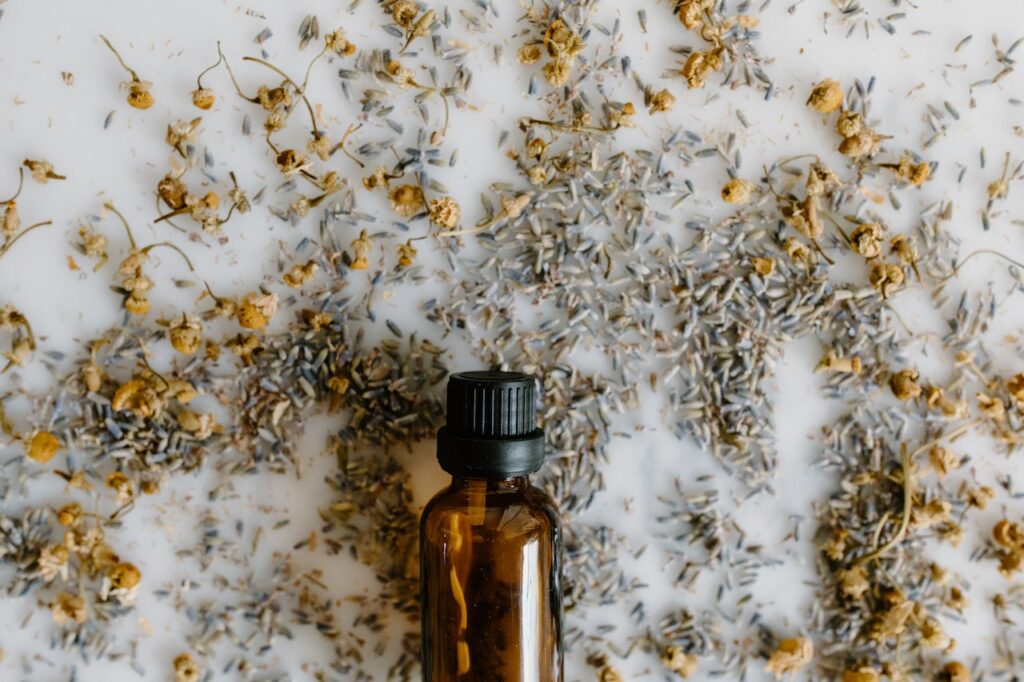
Herbs that enhance health and well-being have been utilized for ages by people from many different cultures. Many of these plants include substances that have been found to have potential health advantages. However, their efficacy may differ from person to person. Here are some popular medicinal plants along with the health advantages they bring.
Ashwagandha
For its therapeutic qualities, Ashwagandha has been utilized for thousands of years. The adaptable herb is frequently used in Ayurvedic medicine (India’s ancient medical system) to increase energy, lower stress, and anxiety, and lessen pain and inflammation. According to research, this potent herb dramatically lowers cortisol levels, which is the main stress hormone, and contributes to a reduction in anxiety and stress.1 It is acknowledged as an adaptogen, a chemical that aids in stress protection.
As the herb can raise male testosterone levels, Ashwagandha is also utilized to enhance male sexual health. Smith SJ, Drummond PD, and Lopresti AL. In an aged, overweight male population, a randomized, double-blind, placebo-controlled crossover trial was conducted to examine Ashwagandha’s hormonal and vitality benefits (Withania somnifera). The woody plant’s root is thought to assist impotence, boost libido (sexual desire), and improve sexual pleasure.
As a dietary supplement, Ashwagandha is offered in pill, tincture, and powder forms. Ashwagandha powder is best added to beverages like smoothies, desserts, coffee, or tea because it may include an earthy, bitter taste. Traditionally, it was combined with ghee, honey, or water.
Add ashwagandha powder to smoothies or hot drinks; use 1/4 to 1/2 teaspoon. Ashwagandha can be taken at any time of the day. However, it is most effective taken around Thirty minutes before a meal. Most individuals do not experience Ashwagandha’s effects right away. It may take many weeks before Ashwagandha’s advantages become apparent.
Most adults can safely use Ashwagandha. Drowsiness, stomach pain, and diarrhea are typical side effects. Benzodiazepines, Anticonvulsants, & barbiturates are just a few examples of pharmaceuticals that should not be used by those who take the plant because of potential interactions. If pregnant, avoid taking Ashwagandha since large amounts might cause miscarriage.
Echinacea
A blooming plant belonging to the daisy family is echinacea. The flower’s big, pink petals open in the early to late summer. Echinacea’s root, stem, and leaf are frequently used as medicines. It grows in eastern & central North America. Echinacea has long been used to treat conditions like toothaches, intestinal discomfort, convulsions, snake bites, skin rashes, arthritis, and cancer. Echinacea is a traditional herbal treatment used today to treat or prevent a common cold & flu. It is frequently used to enhance wound healing as well.
Echinacea has a variety of compounds that have been linked to antiviral, antioxidant, and pain-relieving properties. According to some research, using echinacea to avoid upper respiratory infections may have a little positive effect. However, further research is required to discover whether it can prevent or lessen the duration of a cold.
Echinacea may irritate the stomach and be difficult for the digestive system. Echinacea can only be taken temporarily, according to experts. Use for eight weeks or longer might impact the liver and immunological system of the body. Before utilizing echinacea, consult a medical professional. It may interfere with your prescription drugs, especially those with liver-related side effects. Echinacea may cause an adverse response if you are sensitive to daisy family members, including ragweed, marigolds, and daisies.
Garlic
The fragrant bulbs of the perennial garlic plant, which is native to Central Asia, are what makes it popular. Many civilizations now cultivate it all over the planet. In addition to being used in cooking, garlic has medical benefits. Humans have used garlic for thousands of years. Preventing infections, controlling blood pressure, and treating colic, liver illness, intestinal worms, and TB are only a few of the traditional medicines’ purposes.
Garlic contains substances that are antibacterial, anticancer, and anti-inflammatory. According to research, garlic helps lower blood pressure & cut the risk of stroke or heart attack. See your doctor first if you intend to use garlic supplements for health reasons. If you use blood thinners, avoid using garlic, which might raise your bleeding risk. National Center for Integrative and Alternative Medicine. Garlic.
Avoid taking a lot of garlic preceding surgery or dental operations for the same reason. Certain cancers may be successfully prevented by garlic. According to research, eating cooked or raw garlic often may lower the risk of colorectal cancer.
Chamomile
The chamomile flower is indigenous to Asia, India, and Western Europe. It now spreads unchecked over the entire country. German chamomile grows in the Midwest, and Roman chamomile is a perennial with an apple-like scent. In the US, chamomile is a widely used herbal treatment for calming the mind and promoting relaxation. Chamomile tea is “likely safe,” according to the National Center for Integrative Health and Complementary Medicine, a part of the National Institutes of Health. Additionally, it could be secure for short-term oral usage. The long-term safety of taking chamomile as a medicine needs to be better understood.
In the European continent, chamomile promotes wound healing and lessens swelling and inflammation. The success of this herbal treatment supports its widespread use. According to a review from 2016, chamomile is a useful plant. It is frequently used for its anti-inflammatory, depressive, antibacterial, antioxidant, and antidiarrheal properties. Additionally, it helps with gastrointestinal diseases, premenstrual syndrome, ulcerative colitis, and knee osteoarthritis.
Ginger
The Ginger (Zingiber officinale) features yellow-green blossoms and a leafy stalk. Ginger is a Zingiberaceae family member and is indigenous to Asia and India. The versatile spice, used worldwide in meals and beverages, is derived from the ginger plant’s underground stem. The fresh rhizome of Zingiber officinale Roscoe, also known as Zingiberis Rhizoma Recens, is utilized in traditional Chinese medicine.
Since the 1500s, ginger has been a common ingredient in many traditional remedies worldwide.15 Ginger was so highly regarded and sought after over 2,000 years ago for its therapeutic benefits that a pound cost the same as a sheep. Common illnesses, including nausea, discomfort, and vomiting, were treated with it. These days, ginger has the difference of being categorized as a food, medicinal, and herb.
Regarding its therapeutic benefits, ginger is most well-known for its capacity to ease nausea. According to research, ginger may reduce nausea and vomiting in pregnant women and those having surgery16. Ginger may also lessen nausea brought on by chemotherapy. Ginger is a potent pain reliever due to its anti-inflammatory & antioxidant qualities. According to one research, ginger helps osteoarthritis patients feel less pain and move more freely.
When applied topically (on the skin), ginger is considered safe. It is also considered safe when taken orally as a food supplement. When used excessively, the side effects, which are often moderate, include heartburn, diarrhea, & stomach pain. Although consuming ginger during pregnancy is generally regarded safe, if you wish to lessen pregnancy-related nausea and vomiting, consult your healthcare provider before using it.
Gingko
One of the oldest living tree species is Ginkgo biloba, sometimes called ginkgo. Ginkgo, an Asian native, is one of the most popular herbal treatments in the country. Extracts, pills, and tablets made from ginkgo leaves are also available. Tea made from ginkgo leaves is also an option. Traditional Chinese medicine also treats wheezing with the nut.
Ginkgo leaves have been employed for their therapeutic properties for thousands of years. Treatments for bronchitis, asthma, chronic tiredness, and tinnitus (ear ringing) are among them. More research is necessary to discover whether the remarkable brain-boosting claims about ginkgo are accurate.
You may get ginkgo in capsules, tablets, liquid extracts, and dried leaves/tea. Ginkgo presently has no suggested standardized dosage. Varied research investigations have employed varied dosages and formulations. Your age, sex, medical history, & the formulation being used will all affect the appropriate dose for you. To find the best dosage for you, starting with a lesser dose is often preferable. Any health advantages of ginkgo may not become apparent for up to six weeks.
Ginseng
The well-known plant ginseng is said to provide several health advantages. There are several varieties of ginseng, sometimes called “man-root” due to its human-like form. Panax quinquefolius, a herbaceous perennial endemic to deciduous woods in the United States, is American ginseng. Eastern Siberia, China, and Korea are the original home of Asian ginseng (Panax ginseng). The term “panacea,” which refers to ginseng’s numerous therapeutic benefits, is the source of the scientific name Panax.
In conventional Chinese medicine, Siberian ginseng is also known as eleuthero or ci wu jia. Compared to the other varieties, it serves more as an adaptogen and is less of a tonic. The herb Panax notoginseng, also known as Radix notoginseng or Sanchi, has been used for centuries to stop bleeding.
For thousands of years, traditional Chinese medicine has utilized ginseng. The plant is still used often for therapeutic purposes today thanks to its antiviral, anticancer, anti-inflammatory, anticancer, and anti-obesity effects. According to research, ginseng increases immunity, circulates more freely, and guards against several cancers. Additionally, it has been demonstrated that the potent plant lowers blood sugar and enhances diabetic therapies.
Ginseng is a well-liked anti-aging herb to boost brain health in older persons since studies have shown that it enhances learning and memory development. It has been demonstrated that ginseng has the same potency for pain treatment and inflammation reduction as nonsteroidal anti-inflammatory drugs (NSAIDs).
Lavender
The Lavender (Lavandula), a fragrant evergreen shrub that grows in low hills and is indigenous to the Mediterranean, is one of the most widely used herbs in the world. Lavender, a member of the mint family, is a popular plant worldwide. The adaptable herb, used in essential oils, baking, and personal care products, has become one of the most researched herbs because of its possible health advantages.
Since ancient times, people have utilized lavender for everything from fragrances to aromatherapy to therapeutic uses. Traditional uses of the herb’s healing abilities included the treatment of burns, insect stings, wound cleansing, and illness prevention.
According to research, lavender helps with mood enhancement, pain relief, memory enhancement, and sleep promotion. Lavender has been shown to have antioxidant, anticonvulsant, anti-inflammatory, & antibacterial properties in investigations on both humans and animals.
The Lavender is a potent plant with many therapeutic and medical applications. Lavender essential oil’s relaxing qualities may make it useful for reducing anxiety and encouraging restful sleep. In addition to reducing discomfort, the essential oil has been shown to ease headaches, back pain, menstrual cramps, and joint and arthritic pain.
Turmeric
Turmeric is a herbaceous perennial plant indigenous to South Asia and a member of the ginger genus. For more than 4,000 years, it has been utilized for its therapeutic benefits. One of the plants that has been studied the most is turmeric. It possesses anti-inflammatory, bacterial, anti-antioxidant, and anticancer effects. It is used for upper respiratory tract infections, digestive issues, and skin issues in Ayurveda and other traditional medical systems.
Still, a common natural treatment is turmeric. Allergies, arthritis, digestive issues, depression, respiratory infections, & liver disease are among the diseases it is said to help with. According to research, using turmeric topically on the skin or taking it orally may have therapeutic advantages for skin health. Turmeric has also been shown to lessen arthritis-related joint discomfort effectively. According to one research, people who consumed 100 milligrams of turmeric extract daily reported less joint discomfort.
When ingested as a food ingredient, taken orally as a supplement, or used topically in the prescribed dosages, turmeric is considered safe. When consumed in large amounts, the key element in turmeric, curcumin, can irritate the stomach and result in diarrhea, skin rashes, yellow stools, and headaches. Curcumin concentrations are greater in supplements than in meals. Before using a turmeric supplement, see a medical practitioner. Some prescription drugs and other natural treatments may interact with it.
The Difference Between Traditional and Herbal Medicine?
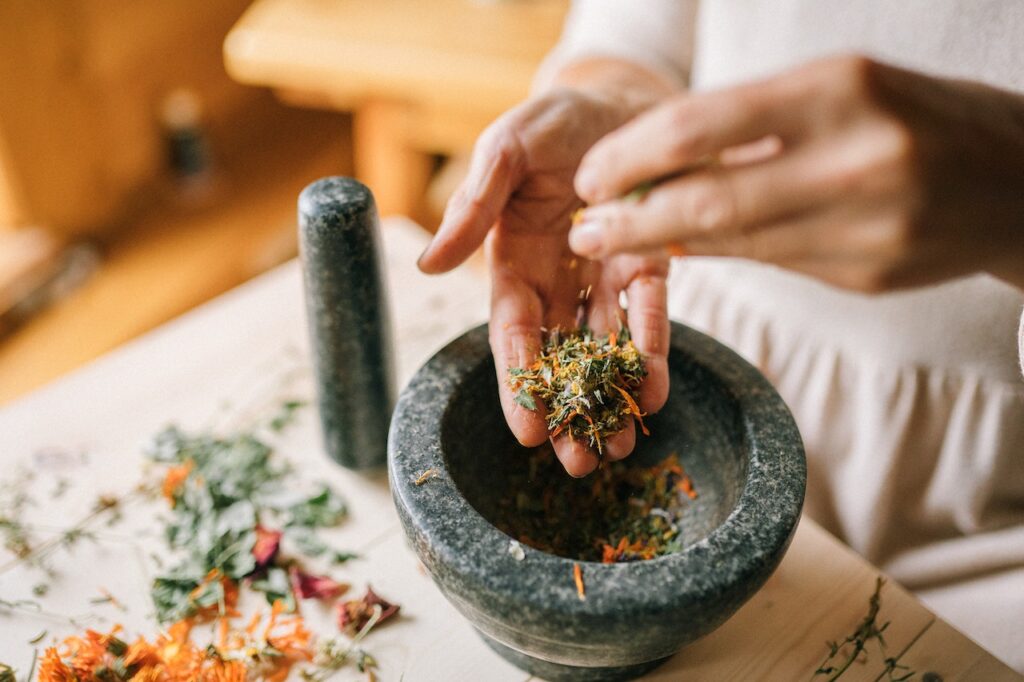
While standard medications treat symptoms that can worsen the issue, herbal therapy works with the body to restore balance. To restore the body’s natural equilibrium, a naturopathic doctor like Dr. Cutler will employ herbal medication, dietary adjustments, and supplements.
Herbal medicine works in harmony with your body to enhance health. However, conventional treatment might make the body even more out of balance than before. Without access to conventional medical treatment, people around the world treat themselves with herbal medicines, and many more utilize herbal remedies sold in stores.
Remember that the efficacy and purity of herbal remedies might vary. To ensure that you obtain a high-quality product free of undesirable ingredients, only utilize products Dr. Cutler has approved as safe and effective. It would help if you relied on a professional’s guidance on herbal medicine, as the FDA doesn’t regulate these medications.
Frequently Asked Questions
Are medicinal herbs safe to use?
When taken sensibly and sparingly, many therapeutic plants are generally regarded as safe. Like any natural or pharmaceutical product, there may be adverse effects, drug interactions, or allergic responses in some people. Before utilizing medicinal plants, it is important to seek advice from a doctor or herbalist, especially if you have a history of health issues or are already on medication.
Which medicinal herb is considered to be the most beneficial?
There is no doubt that turmeric is the most potent herb that can be found anywhere in the world.
What is the most widely used herbal remedy?
Herbal remedies are used extensively to treat medical ailments by people all over the world. There are many different kinds, but some of the most well-liked ones are made of ginkgo, ginger, turmeric, ginseng, & chamomile.
What herbs are anti-infective?
Herbs often used in cooking, like sage, basil, and oregano, & lesser-known varieties, such as astragalus and sambucus, contain potent antiviral properties that are effective against various viruses that cause illnesses in people.
Final Thoughts
My study and research show that people have been using plants to relieve illnesses, pain, and sickness for thousands of years. Herbal remedies can be found in various forms, such as supplements, teas, tinctures, and essential oils. There is a wide range of scientific evidence for common herbal medicines. There may be a lot of information for some people and only a little for others. Before using any treatments, try to study them to learn about any possible adverse effects and their alleged health advantages.

